Posted by Anita on 08.23.07 12:10 PM
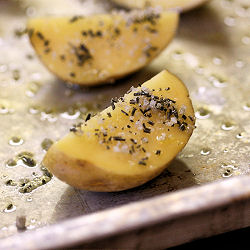 All the cool kids are taking blog-sabbaticals this summer. Oh, how I wish that were the reason why we’ve been so blissfully post-free. Truth is, we’ve got plenty of inspiration, and we’re cooking up a storm. We’ve had a week of meals lined up, shopped for, and planned to a fare-thee-well. But – sadly, right in the heart of the best-eating time of the year – we’re more than a little off our game.
All the cool kids are taking blog-sabbaticals this summer. Oh, how I wish that were the reason why we’ve been so blissfully post-free. Truth is, we’ve got plenty of inspiration, and we’re cooking up a storm. We’ve had a week of meals lined up, shopped for, and planned to a fare-thee-well. But – sadly, right in the heart of the best-eating time of the year – we’re more than a little off our game.
First there were the gnocchi.
As any sane cook will tell you, gnocchi are fraught with peril, even in the best of circumstances. Attempting to devise gnocchi that are somehow simultaneously delicious, gorgeous, and interesting enough to write about adds a serious degree of difficulty. While I am sure there will be plenty of entries in this month’s exciting episode of Hay Hay, It’s Donna Day, my Day-Glo fuschia beet-ricotta gnocchi will not be among them. Fussy, dumpy, and not terribly tasty… it’s not too strong to call this an outright failure.
Then there was the antipasto salad. I think it’s safe to say that Nancy Silverton is decidedly not targeting my demographic with her latest book, A Twist of the Wrist. It’s a cool, heartfelt attempt at legitimizing the semi-homemade trend, streamlining weeknight dinners with the judicious application of store-bought gourmet goods. Like tapenade.
Oh, the tapenade.
Trust me, kids, it was all I could do to fight the urge to just buy some good olives and slap them in the Cuisinart with a splash of olive oil and a spoonful of capers – completely eliminating the book’s time-saving charm. So I didn’t; I bought a nice-looking bottle of chunky green-olive paste and added it to my pile of lettuce, salami, and herbs.
You know where this is going, eh?
Salty, metallic and otherwise irredeemably bad, the store-bought ‘tapenade’ overpowered all of the other ingredients – and I’d only used half what the recipe called for. I don’t think we actually tossed it all down the drain, but it was a near thing; there was a lot of picking good salami and cheese out of the hyper-salinated salad.
Returning to familiar territory, we pulled out a tried-and-true recipe for Thai shrimp-cakes from Dancing Shrimp. Our makrut lime tree is finally bearing fruit, and these savory morsels seemed the perfect way to showcase our harvest for Andrea’s “Grow Your Own” roundup. As I pulled all of the ingredients out of the fridge, I caught a whiff of the ‘fresh’ shrimp we’d bought at Whole Foods: It had spoiled overnight. (That will teach me to sleep in and skip the market. This would not happen at Shogun.)
Feeling defeated, we cannibalized a meal we’d planned to eat later in the week: Rib-eye steak and rosemary salt-roasted potatoes. It was fine, I guess, although we both picked through the definitely-not-Prather-quality meat and the too-sweet supermarket spuds.
Last night, in need of a sure thing, we hoofed it all the way down the peninsula to our favorite Mexican restaurant. We’ve eaten there for more than 10 years now, always bragging that we’d only ever had one bad meal there. Well, now we can say we’ve had two: Unmelted cheese, blown-out rice, tortillas heated to the point of hand-scorching rubberiness, and a squeaky-dry chicken tostada. At least the margaritas were good.
With the exception of a lovely dinner at Oliveto on Monday, I can honestly say that there were exactly two meals over the last week that I truly enjoyed: a fluffy Denver omelette I made from piperade leftovers, and a bowl of Rancho Gordo’s giant lima beans simmered with onions that had been sautéed in bacon drippings.
Amid an overwhelming collection of intricate disasters and well-planned flops, these simple, graceful plates stand out as a steady reminder: Sometimes even the best-laid plans are no match for kitchen kismet, and sometimes less is more.
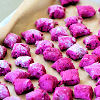

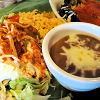
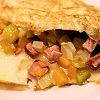
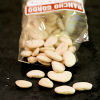
Denver Omelette
3 large eggs
1 T half-and-half, or cream
2 T butter
1/2 cup diced onion
1/2 cup diced bell pepper
1/2 cup small ham cubes
1/4 to 1/2 cup shredded cheddar cheese
In an 8-inch skillet, melt the butter over medium heat. Saute the onions until they just begin to soften. Add the pepper, and saute until vegetables are well softened but not browned. Add the ham cubes and saute until heated through. Remove sauteed ingredients to a plate and keep warm. Return the skillet to the fire.
In a medium bowl, scramble the eggs and the half-and-half until well blended and a little frothy. Add the beaten eggs to the hot pan, and let sit for 15 seconds; stir gently with a wooden spatula, pulling the curds toward the center of the pan and encouraging liquid to fill in the gaps. When a little liquid remains, use the spatula to gently even out the thickness of the curds in the pan, and reduce the heat to low. Spread the cheese all over the soft-set eggs, then evenly top one side of the omelette with the filling. Cover the pan and let sit for a few minutes until cheese melts. (If the underside of the egg browns too much, turn off the heat entirely; the pan will be hot enough if you leave the lid on. Unlike a French omelet, you do want some color and crispness, but you don’t want leathery eggs.)
When cheese is melted, fold the unfilled side of the omelette over the filling. Slide onto a warmed plate, glazing the top with a bit more butter, if desired.
Serves 2 with salad as a light supper, or a very satisfying breakfast for one hungry soul.
breakfast, cookbooks, cooking, other blogs, recipes
8 Comments »




Posted by Anita on 08.17.07 7:03 AM
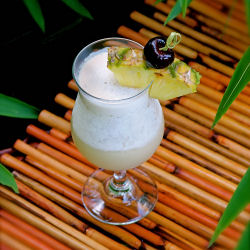 The piña colada enjoyed its 15 minutes of fame in 1979, long before the idea of cocktails really entered my brain. The reason: A pop song by one-hit-wonder Rupert Holmes called “Escape”… better known as “The Piña Colada Song“.
The piña colada enjoyed its 15 minutes of fame in 1979, long before the idea of cocktails really entered my brain. The reason: A pop song by one-hit-wonder Rupert Holmes called “Escape”… better known as “The Piña Colada Song“.
Unfortunately, just like the song, most piña coladas are saccharine-sweet and filled with all kinds of nasty things you’d rather not think about. The list of ingredients on your average can of coconut creme — hydrogenated soybean oil? polysorbate 80? — is almost as gag-inducing as the idea of a married couple cruising the personals and accidentally answering one another’s ads.
But, in the name of retro authenticity, we went ahead and tried it the usual way, with Coco Lopez and store-bought pineapple juice. We got one sip into our drinks before deciding that all we could taste was chemicals and cans, and dumping them down the drain.
We bought a coconut and briefly toyed with the idea of making our own cream. But, realistically, if we’re not willing to go to such lengths to make a curry, why the hell would we do it for a cocktail? Thinking along these lines, we cracked a can of Thai coconut milk and skimmed off the cream, adding a little simple syrup for sweetness. Good idea, terrible outcome: The homemade version was unpalatably greasy, even after a spin in the blender. We gave up the idea and moved on to other drinks.
But when one of our favorite cocktail blogs decided to host a tiki cocktail contest, our thoughts returned to the unfinished experiment: the piña colada that we knew just had to be possible. We hunted high and low for chemical-free recipes, but every last one seemed to be in thrall to Señor Lopez and his additive-addled faux de coco.
During a stop at Trader Joe’s last weekend, we stumbled on the perfect antidote right there in the freezer: An all-natural coconut sorbet. After a little research, we discovered that a handful of brands offer similar products, most with few adulterating ingredients beyond coconut and water and sugar. We tinkered with Gary Reagan‘s blended piña colada recipe to adjust for the natural products’ sweetness or lack thereof. Different sorbets (not to mention different pineapples) will require your own good judgment, so think of the measurements below as a blueprint more than a hard-and-fast recipe.
Whatever your final mix, though, please promise me you’ll steer clear of the personals.

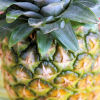


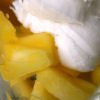
Piña Colada au naturel
— makes two
1/2 pint coconut sorbet
1/2 cup pineapple chunks (fresh or frozen)
1 cup crushed ice
2 oz pineapple juice (preferably fresh or from frozen concentrate)
4 oz dark rum
pineapple (wedge, chunk, or spear), for garnish
maraschino cherries, for garnish
In a blender, combine all the ingredients except the rum, and blend until ice is well blended. Add the rum and pulse until well combined. Pour into two chilled hurricane glasses, and garnish with the pineapple wedge and cherry; paper parasols or plastic monkeys are, of course, optional but highly desired.
Drink of the Week, drinks, other blogs, recipes
11 Comments »




Posted by Anita on 08.15.07 12:31 PM
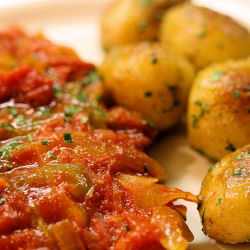 Julie Powell notwithstanding, most cooks discovering Julia Child’s recipes for the first time seem mysteriously drawn to the most labor-intensive and luxurious among them. Apparently, this isn’t strictly a modern phenomenon: In his entertaining book The United States of Arugula, David Kamp recounts this very same thing happening when Child’s first book debuted, poking gentle fun at those who “deliberately chose the most difficult [recipes] to execute when company was coming.”
Julie Powell notwithstanding, most cooks discovering Julia Child’s recipes for the first time seem mysteriously drawn to the most labor-intensive and luxurious among them. Apparently, this isn’t strictly a modern phenomenon: In his entertaining book The United States of Arugula, David Kamp recounts this very same thing happening when Child’s first book debuted, poking gentle fun at those who “deliberately chose the most difficult [recipes] to execute when company was coming.”
Among these over-the-top creations, Kamp makes much of the overwrought dish known as Veau Prince Orloff, “a display piece consumptive of enough time and money to garner status.” I looked up the offending recipe in my own copy of Mastering the Art of French Cooking, and felt a little queasy: The damned thing goes on for three full pages and contains — I kid you not — no less than a dozen sub-recipes.
Luckily for those of us who don’t have days to spend in the kitchen, Julia’s chef d’oeuvre also offers up simple recipes in spades. Scattered among the aspics and the suprêmes and the canard a l’orange lies a wide assortment of bistro classics and a fair number of recipes that rise no higher than the cuisine de bonne femme of everyday French households. Kamp recounts Julia herself choosing the simple potage Parmentier as the book’s first recipe “so that her audience would not be intimdated.”
When I pull out my Grandpa‘s battered copy of Mastering, these are the sorts of recipes I crave: The Provençale garlic soup, the mushroom quiche, the steak au poivre. So when Lisa at Champaign Taste proposed her second-annual blog party to honor the 95th anniversary of Julia’s birth, I knew right away the sort of dish I’d share. Sure, it’s not going to win any beauty contests, but it’s a delicious and satisfying plate full of seasonal flavors with a subtle French flair.
Julia recommends serving this humble “Ham Slices Baked with Tomatoes, Onions and Peppers” alongside her sauteed potatoes — and really, folks, how can you pass that up that kind of good advice? While I prepped the piperade, Cameron peeled a pound of baby spuds and trimmed them to roughly the same size, browned them in butter and oil, then covered them to steam until tender. Along with a bottle of French rosé, they were the perfect foil for the tangy, salty richness of the ham. We raised our glasses to the warbly voiced girl from Pasadena, and counted ourselves truly lucky to have lived in her era.


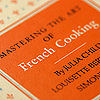
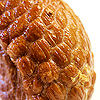
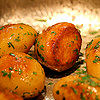
Jambon en Pipérade
– adapted from Mastering the Art of French Cooking
Cook’s note: Julia simply calls for “peeled, seeded, juiced and sliced” tomatoes; I’ve complicated matters a bit by explaining how you get there. If you dispense with peeling your own tomatoes and opt for good quality whole canned tomatoes — like Muir Glen — you’ll need 2-1/2 cups of tomato pulp plus about 3/4 cup of their juice. Go this route and this simple dish can be on the table in less than 45 minutes.
2 pounds cooked ham, sliced 1/2-inch thick
1 to 2 T bacon fat or olive oil
1 cup sliced yellow onions
1 cup sliced green bell peppers
2 pounds firm, ripe, red tomatoes
2 cloves garlic, mashed
1/8 tsp pepper
pinch of cayenne pepper
1/4 tsp fresh thyme
2 T minced parsley
Preheat the oven to 350°. Meanwhile, bring a saucepan of water to a boil.
While the water heats, prepare an ice-water bath in a large bowl. Peel the tomatoes by scoring an ‘x’ in the bottom of each, then dropping into the boiling water. When the skin begins to peel away from the ‘x’, remove from the pan with a slotted spoon, and drop each tomato in the ice-water bath. When cool enough to handle, remove the tomato and peel off the skin. Proceed with the remaining tomatoes until all are peeled.
Cut each tomato in half, and remove any hard core or stem section. Squeeze the juice and seeds out of the fruit, reserving on the edges of the cutting board (or in a bowl if they become overwhelming). Slice the squeezed tomato flesh into regular pieces. Set aside the tomato flesh and the tomato seeds/juice separately.
Trim any excess fat off the ham, and dry each slice on paper towels. Heat the fat in your largest skillet until it is almost smoking; then brown the ham for a minute or two on each side. Remove ham from skillet and place in a shallow baking dish large enough to hold the ham in one layer. (A slight overlap is fine.)
Lower the heat and stir the onion slices into the fat. Cook over medium-low heat for 5 minutes. Stir in the peppers and cook 5 minutes more, or until the vegetables are soft but not browned.
Place the tomato pulp over the onions and pepper, and continue to cook over medium-low heat. While this is happening, scoop the tomato seeds and juice, along with any seed jelly, into a strainer, and add the strained liquid to the skillet.
Push the solids to one side of the pan, and tilt the skillet to allow the liquids to gather on the now-empty half of the pan. Arrange the skillet off-center on the burner so that the juice side of the pan is directly over the flame, and the vegetables are further away. Simmer until the juices become minimal, stirring everything together and re-dividing every few minutes, to make sure that the juices reduce without overcooking the vegetables.
When the tomato juice has almost evaporated, stir it back into the vegetables and cover the browned ham slices with the mixture. Cover the baking pan with foil, and place in the preheated oven. Cook for 20 to 30 minutes, until the ham is heated through and tender. Baste with juices in the dish, then correct seasoning if necessary. Garnish with chopped parsley, and serve with sauteed potatoes.
cookbooks, holidays & occasions, meat, recipes
7 Comments »




Posted by Cameron on 08.14.07 9:58 PM
 Sometimes, my palate is a live illustration of the law of unintended consequences. The combination of our sausage-making party and the constant talk about preserving food that comes with summer rattled around in my subconscious for weeks.
Sometimes, my palate is a live illustration of the law of unintended consequences. The combination of our sausage-making party and the constant talk about preserving food that comes with summer rattled around in my subconscious for weeks.
Then, on a Saturday morning as we did our shopping, we passed by Shogun Fish at the market. They were advertising the first local wild salmon of the season and a relay closed somewhere in my head. Suddenly, I wanted gravlax, and I wanted to make it myself.
On the hunt for a recipe, I turned to Tom Douglas’ Seattle Kitchen. Tom is my first stop when I need wisdom about salmon, and his advice mostly lined up with other recipes and random commentary that I found around the InterWebs. I guess. The big differences were the addition of ground juniper berries (possibly traditional) and the absence of dill (definitely untraditional), and the presence of some other spices.
Fennel? Cayenne? Okay, whatever.
In theory, I knew that the process wasn’t difficult: just a simple salt/sugar cure. But I had no idea how dead-freakin’-easy it would be. Just pack the dry cure over and around the fish, weight the whole pile down with cans or what-have you, refrigerate, wait a few days and POW! Instant gravlax. Seriously, the hardest thing about this whole project was picking the juniper berry flecks out of the finished product. Obsess much? No! Yesssss. (Who said that?)
I love this stuff. I eat it for breakfast — with soft scrambled eggs, yum — for lunch, for a snack, whenever. For my next batch I’m going to try vacuum-sealing and freezing some to see how it holds up.





Gravlax
1-1/4 pound salmon fillet, preferably skin on, pin bones removed
Cure
2/3 cup kosher salt
2/3 cup granulated sugar
1/4 cup firmly packed brown sugar
1 1/2 teaspoons paprika
1 teaspoon ground juniper berries
1 teaspoon fennel seeds, ground
1/4 teaspoon cayenne
Combine the cure ingredients in a small bowl. Sprinkle the bottom of a non-reactive baking pan with about 1/2 inch of the cure and place the fish in the pan, skin side down. Blanket the fish with the remaining cure, creating a layer about 1-1/2 inches thick.
Cover the salmon with a piece of wax paper and top with another smaller pan, then weight the top pan down with a few cans. Store in the refrigerator for two to three days until the salmon is quite firm to the touch; the exact amount of time will depend on how thick your piece of salmon is. Remove the wax paper and the cans, and then use a rubber spatula to scape the cure from the salmon. Remove the salmon from the pan and briefly rinse it, then pat it dry with paper towels. To serve, slice the gravlax very thinly on the bias.
Cook’s note: I was not shy at all about rinsing the gravlax under cold running water until the cure was gone, daddy gone.
breakfast, meat, preserving & infusing, recipes
5 Comments »




Posted by Anita on 08.10.07 7:08 AM
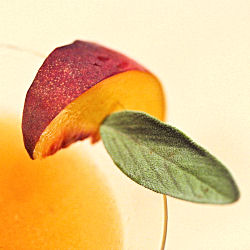 Last year, I put myself on a book diet. Watching my ever-expanding kitchen library take over the countertops, I knew the time had come for serious change. I still allowed myself to purchase cookbooks, but only after thoroughly vetting them first. Usually, this involved borrowing the book from a friend, or from the public library.
Last year, I put myself on a book diet. Watching my ever-expanding kitchen library take over the countertops, I knew the time had come for serious change. I still allowed myself to purchase cookbooks, but only after thoroughly vetting them first. Usually, this involved borrowing the book from a friend, or from the public library.
Even though it’s been difficult to curb the urge to acquire every buzz-worthy title on the market, the system that I fondly call “the new cruelty” has saved me from buying more than a few turkeys. The number of additions to our library has been small, but every one of them gets used regularly.
My real problem, though, was bar books. I’m the abashed owner of what any normal foodie would consider to be an unseemly quantity of cocktailian tomes. Given the vast amounts of spiritous inspiration lurking around every corner of the Internet, my hoard has proven truly unnecessary. In the strictest sense, most mixology manuals aren’t even all that inspirational — they often lack photos, and they’re typically burdened either by purple prose or too-clinical content. Enough, I said, was enough.
So while everyone else swooned over The Art of the Bar during its debut, I smugly folded my arms and turned my head. I have plenty of drinks books, I told myself. Besides, I’m not even that fond of Absinthe (the authors’ place of employment, that is, not the aperitif).
But one afternoon with some time to kill between mid-day appointments, I found myself in front of a local bookstore. I popped inside and headed down to the cookbook department. Grabbing a few titles and heading to the nearest bench, I was sucked into to The Art of the Bar by beautiful full-page photos, artfully styled but still obviously real. The copy was engaging, and the recipes — I grudgingly admitted — were interesting without being too “out there”. In short, it was the cocktail book I could justify buying.
But still I stood my ground for months, even after discovering that the San Francisco Public Library — quite scandalously — does not own a copy of this widely acclaimed title (all the more amusing because you could almost hit Absinthe with a muddler thrown from the roof of the Main Library). After finally scrounging a copy through interlibrary loan, it didn’t take more than a few test drinks to know that my moratorium would crumble.
Living with one of the world’s most unrepentant punsters, it’s not surprising that one of the first recipes I flagged was a little number called Peaches & Herb. Stone fruits had just burst into season as my very own copy arrived on our doorstep, and the new sage plant was thriving — truly, my path was clear.
We’ve been mixing up a batch of these beauties almost every week for the last month, trying little variations here and there. You’ll be pleased to know that orange bitters, or even Angostura, can take the place of the requested peach bitters (although the original is undeniably better).
This month’s edition of Mixology Monday asks us to think orange — and the lovely P&H qualifies twice, both by virtue of its sunny color and one of its key ingredients. Even if you’re colorblind you’ll definitely want yellow peaches here; their white siblings clash with sage’s herbal intensity. And although brandy makes for some mighty smooth sipping, I’d be remiss if I didn’t recommend bourbon as a tremendously interesting variation.


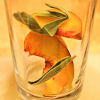


Peaches & Herb
– from The Art of the Bar, by Jeff Hollinger & Rob Schwartz
3 to 4 slices of peach, plus 1 slice for garnish
3 to 4 fresh sage leaves, plus 1 leaf for garnish
splash of simple syrup
1-1/2 oz brandy (or bourbon)
1/2 oz Cointreau orange liqueur
2-3 dashes peach bitters
1/4 oz lemon juice
 In a mixing glass (or cocktail shaker), muddle the peach and the sage with the syrup (if needed, depending on the sweetness of the peach), to make a pulp. Top with ice; add the brandy, Cointreau, bitters, and lemon juice. Shake your groove thing until cold, and strain into a chilled cocktail glass; garnish with remaining peach slice and sage leaf.
In a mixing glass (or cocktail shaker), muddle the peach and the sage with the syrup (if needed, depending on the sweetness of the peach), to make a pulp. Top with ice; add the brandy, Cointreau, bitters, and lemon juice. Shake your groove thing until cold, and strain into a chilled cocktail glass; garnish with remaining peach slice and sage leaf.
cookbooks, Drink of the Week, drinks, Mixology Monday, recipes
10 Comments »




Posted by Anita on 08.08.07 4:25 PM
 It’s good to have friends among the landed gentry. In the warm suburbs beyond the fog-wrapped City limits, we’re on friendly terms with plenty of folks who find themselves rolling in a bumper harvest of astonishing variety, looking for creative ways to eat everything before it goes off. Meanwhile, we slickers sit on our decks and wonder if the tomatoes are ever going to ripen, if the basil will survive another week, if the mint might yield enough leaves to make a couple of cocktails before the summer ends.
It’s good to have friends among the landed gentry. In the warm suburbs beyond the fog-wrapped City limits, we’re on friendly terms with plenty of folks who find themselves rolling in a bumper harvest of astonishing variety, looking for creative ways to eat everything before it goes off. Meanwhile, we slickers sit on our decks and wonder if the tomatoes are ever going to ripen, if the basil will survive another week, if the mint might yield enough leaves to make a couple of cocktails before the summer ends.
One of my favorite new friends calls herself a “tomato-ranchin’ bum.” Really, she’s more like a pear-wrangler these days, burdened under so much fruit that she’s resorted to using her harvest as dog toys and paperweights. The poor dear. Of course, we’re green and yellow with envy: Cookie gets more fruit off her newly inherited pear tree in one day than we coaxed from our plum during in its entire (and entirely too short) season.
Knowing that we’re suckers for home-grown fruit, Cookie loaded us up with a jar of eye-rollingly delicious homemade pear butter and an entire grocery bag full of her surplus pears. Not that I am complaining, mind you… not in the least. When we got home, we separated the as-yet-unripe specimens into their own bowl, to help preserve our bounty as long as possible. The ripest of the already-yellow bunch got scrubbed, split, cored, and cubed, then plunked into brandy. By the end of the second night, I could tell we’ll have a winning tipple on our hands in short order. (It’s not going to put Belle de Brillet out of business, but it definitely qualifies as Majestique de Marin already.)
Meanwhile, we’re stuffing ourselves with a warm-weather riff on the salad we ate all last winter: Slivered pears — ripe but still crisp — tossed with spicy arugula (also from CookieCrumb Acres), some flavorful olive oil, and a touch of mild vinegar. Crumble a little Point Reyes Blue on top, ’cause we love it even if the cool kids don’t. Crack a little pepper over the top, and there you have it: A perfect summer salad for those nights when you just can’t bear another caprese.
Anyone else out there with surplus gourmet edibles? Call me — let’s talk.





cooking, other blogs
7 Comments »




Posted by Cameron on 08.06.07 10:28 PM
 Okay, honest, I never intended for this garden tour to become a summer-long thing. I started in June, figured that I’d post a few times and be done by early July. Now here it is August already. Where do the days go?
Okay, honest, I never intended for this garden tour to become a summer-long thing. I started in June, figured that I’d post a few times and be done by early July. Now here it is August already. Where do the days go?
For those of you just joining us, this is the third installment of a tour of our backyard, which we reclaimed from ugly ignominy just over a year ago. In our last episode, we braved the Northside Fruit Preserve and the Eastern Wall. What adventures lie ahead?
On the south side of the yard, we see the fence that separates the garden from the dog run. Until mid-June, it was blanketed in passion fruit vines that seemed like a good idea when we planted them. However, “fast-growing and aggressive” does not begin to describe these guys. After only a single year, two plants completely covered a 25-foot fence and needed to be trimmed practically every day. After being grimly and colorfully assured that we hadn’t seen anything yet, we decided to eliminate the vines before they ate one of the dogs.
However, we’re not sure that we haven’t forsaken the frying pan for the fire. In the place of the passion fruit, we installed four Golden hop vines purchased from the farmer’s market. We’ve always wanted to grow hops, but have never had the motivation, garden space, season, and rhizomes come together at the same time. Planted in late June, the hops have already enthusiastically twined through the fence and are waving feelers around above the rail line. But for some reason, I feel more kindly toward these particular fast-growing, aggressive vines than I did the passion fruit.
Theoretically we could use the hop flowers to make beer, but it’s more likely that we’ll take the advice a passerby at the market gave us as we were buying the plants. Apparently, hop-shoot risotto is a done thing in some parts of Italy (and elsewhere?). If you have any recipes, please share!
In front of the south fence, we have line of herbs (two thyme plants, one oregano, and one sage plant) that define the most serious, working part of our garden. We’re down there clipping fresh bits for cooking at least once a week. Our herb crew has battled through adversity: the oregano fell prey to a mite infestation last year, and our original variegated sage plant died shortly after it was planted. But the oregano has come bounding back, and we recently replaced the sage. Everything is growing like gangbusters, especially the thyme.
The fact is, “growing like gangbusters” describes everything that we’ve put in — a state of affairs that I attribute to the gentle microclimate that favors our patch. When we originally planned the yard, I chose plants that would produce food, but that wouldn’t require much tending. But now, flushed with success, I’ve found myself contemplating a true vegetable garden. A small one, mind you.
In the meantime, the sun is out, and there’s a chair on the patio near the magnolia with a good book and a tall, cool glass of something refreshing waiting for me.





garden
4 Comments »




Posted by Anita on 08.03.07 7:03 AM
 If you want to play baseball with four strikes in an out, I’m not stopping you. Throw a party on February 31 — knock yourself out. Put “i” after “e”, wear white shoes before Memorial Day, spit into the wind, and mess around with Jim; I’m sure not going to be the one to tell you no. Because, really — contrary to popular belief — I don’t really give an animated rat‘s backside if you order a Mojito in a midwinter maelstrom. I just hope you know that we’re all laughing at you and the bartender’s spitting in your nachos.
If you want to play baseball with four strikes in an out, I’m not stopping you. Throw a party on February 31 — knock yourself out. Put “i” after “e”, wear white shoes before Memorial Day, spit into the wind, and mess around with Jim; I’m sure not going to be the one to tell you no. Because, really — contrary to popular belief — I don’t really give an animated rat‘s backside if you order a Mojito in a midwinter maelstrom. I just hope you know that we’re all laughing at you and the bartender’s spitting in your nachos.
In this permissive spirit, I encourage you to make your Bellini with any-ol’ peach puree. Heck, substitute cheap peach schnapps or metallic peach nectar from a can for all I care — I’m sure you’ll love it. But please don’t try to stop me from heading down to the nearest farmers market and finding myself a gorgeous, perfectly ripe heirloom peach. And seeing as how I’m just like that, I’m even going to make it a white peach… Signor Cipriani would be so proud!
You see, these lovely aperitivi are called Bellini not because they’re petite and pretty (which they undoubtedly are, when — ahem — traditionally concocted). But rather, it’s because their decidedly pink blush calls to mind the paintings of a certain Giovanni Bellini, a Renaissance painter who applied a deep, rosy glow to the togas, turbans, and other trappings of his art. Made with a standard yellow Prunus persica, the drink takes on a golden tone — more Klimt than Bellini — so some folks encourage the blush with a touch of raspberry. Which, you know, you could do also. And a very interesting cocktail you would have.
Just don’t make me call it a Bellini, or I’m liable to leave some rude remarks on your blog.





Bellini
1 white peach
1/2 tsp fresh lemon juice
2 to 3 ice cubes
Sparkling wine, perferably prosecco or other off-dry bubbly
Peel and pit the peach. Cut into chunks and place in a blender with the lemon juice and ice. Puree very well, until the ice is liquefied and the peach well blended. (The resulting puree yields enough for 3 to 4 cocktails.)
Place 1-1/2 to 2 oz of the prepared puree in a Champagne flute. Top with sparkling wine, stirring constantly with a bar spoon to prevent too much foaming.
Drink of the Week, drinks, recipes, wine & bubbly
13 Comments »




Posted by Anita on 07.30.07 12:48 PM
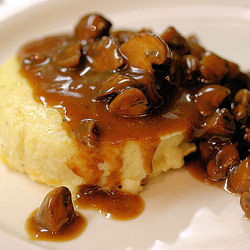 In my new favorite cookbook, Big Small Plates, author Cindy Pawlcyn names her savory corn custard as a brunch favorite. I have no problem believing that this dish flies out of the kitchen, no matter the time of day: We served this recipe a recent dinner party, and our guests all but licked the plates.
In my new favorite cookbook, Big Small Plates, author Cindy Pawlcyn names her savory corn custard as a brunch favorite. I have no problem believing that this dish flies out of the kitchen, no matter the time of day: We served this recipe a recent dinner party, and our guests all but licked the plates.
The first time I made the custard, I used a standard box grater to remove the kernels from their cobs — a messy proposition when dealing with super-fresh farmer’s market corn that spurts milk everywhere. After reading about the Kuhn-Rikon corn zipper in a magazine, I decided to invest in one of these $12 gadgets. Remarkably, it works just like its namesake: Wedge its little crown-shaped tooth at the end of an ear, give a gentle tug, and watch in amazement as two rows of corn unzip right off the cob in perfect alignment.
Does the corn zipper really make this custard better? Given that you end up whizzing the corn to a puree, the answer’s a definite NO. But it certainly makes the prep a lot less messy, and far more amusing. I’d even go so far to say that the corn zipper’s a must-have item if you’re you’re making corn relish or succotash, or any other recipe where whole kernels are a plus, or even if you’re cooking for anyone who loves fresh corn but can’t handle the cob. Yes, Alton acolytes, it’s a unitasker. (But then again, so’s my citrus squeezer, and you’d have to pry it out of my cold, dead hands.) On the plus side: It doesn’t take up much room in the prep drawer, and it’s so freaking cheerful that you just have to smile back — who could resist its happy little face? And as a side benefit, once you own a corn zipper, you’ll have no trouble deciding what to enter into a crazy kitchen gadget event (EDIT: like the one Kathy’s hosting here).
Like other Big Small Plates recipes we’ve tried, this one yields a serious mismatch of sauce and custard quantities. I doubled the sauce on my second attempt, and still ended up with just enough to garnish six servings (albeit rather generously). Either prepare for scantier saucing, or consider doubling the recipe — or at least the stock portion — yet again.




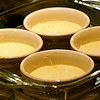
Sweet-Corn Custard with Mushroom Sauce
— adapted from Big Small Plates
Custard
3 ears fresh corn (to yield 2 cups kernels)
2 cups heavy cream
4 large eggs
1 cup (4oz) loosely packed grated Monterey Jack cheese
1 T Dijon mustard
1/2 tsp. salt
1/4 tsp. white pepper
Sauce
4 cups rich stock (beef, chicken, or veal)
2-4 T olive oil
1 pound mushrooms, stemmed and quartered
2 T butter
2 shallots, minced fine
Salt and freshly ground black pepper
Minced fresh chives, for garnish
Using a corn zipper or the coarse side of a box grater, cut the kernels off the cobs. Heat the corn and cream together in a medium saucepan. Bring to a gentle simmer and cook 5 to 10 minutes until the corn is tender. Cool slightly, then puree with a stick blender. (If using a traditional blender, let mixture cool further.) Strain the puree through a fine sieve into a large mixing bowl, pressing well to extract all the liquids. Add the eggs, cheese, mustard, salt, and pepper to the bowl, and stir gently to combine.
Preheat the oven to 325F, and butter eight 6-to-8 oz ramekins. Measure an equal amount of custard into each dish, leaving at least 1/4-inch of headspace. Place the ramekins in a large, shallow pan and carefully fill the pan with enough hot water to reach 2/3 of the way up the side of the ramekins. Cover the pan with aluminum foil, punching a few holes in the top with a skewer, to help prevent condensation drips. Bake the custards in the water bath until just set; start checking at 45 minutes. (The time will depend on the thickness and size of your ramekins, and the size of your water bath.)
To make the sauce, rapidly simmer the stock in a saute pan over high heat until reduced to a sauce-like consistency. Meanwhile, heat the olive oil in another saute pan over medium-high heat. Add the mushrooms and cook, stirring, until they have released their juices and the pan has dried out a bit, 10 to 15 minutes. When the mushrooms are done, salt them to taste and increase the heat to high and pour the stock into the mushroom pan. Bring the stock to a simmer and cook 2 minutes. Just before serving, add the butter and shallots, swirling into the sauce. Season to taste with salt and pepper.
Turn the custards onto individual plates. Pour some sauce over or around each of the warm custards and garnish with the minced chives.
Note: Custards can be kept warm in their water bath for about 20 minutes; if you need to wait longer, refrigerate and gently reheat in a water bath for 10 to 15 minutes before serving. The texture will suffer slightly, but the taste is undiminished.
cookbooks, equipment, other blogs, recipes
12 Comments »




Posted by a Special Guest on 07.27.07 7:04 AM
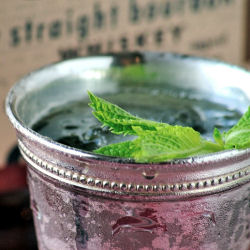 Editor’s note: Inspired by our recent mojito post and his Kentucky-bred husband’s birthday this week, Sean returns to Drink of the Week guest-bartender duties. By featuring this classic, I think it’s safe to say that he’s absolved of any trauma inflicted by his last stint behind the bar. [wink]
Editor’s note: Inspired by our recent mojito post and his Kentucky-bred husband’s birthday this week, Sean returns to Drink of the Week guest-bartender duties. By featuring this classic, I think it’s safe to say that he’s absolved of any trauma inflicted by his last stint behind the bar. [wink]
——
I don’t remember just how I started
I only know that we should have parted
I stole a kiss, and then another
I didn’t mean to take it further
One mint julep was the cause of it all
— “One Mint Julep,” Rudy Toombs
Few cocktails are as storied, as fraught with history and tradition in America, as the mint julep. The very word “julep” evokes a paradoxical domestic exoticism: nostalgic visions of the Old South, of white-bearded men in linen suits coddling dogs named Belvedere. But when was the last time you ordered one in a bar?
Somehow, despite its technical similarities to the fashionable mojito, juleps have yet to catch on as a hipster sipper. Perhaps bourbon’s star has not yet risen as the booze of choice in the way that rye, gin and even cachaça have. (Mind you, bourbon is always in vogue at our household.) Maybe its Southern connotations render it undesirable for the too-cool-for-school crowd. Or could it be the special glassware?
Whatever the case, I am here to tell you that nothing is more refreshing than an ice-cold mint julep, condensation sweating down its sides, on a hot, muggy day. Heck, even on a foggy summer’s day here in San Francisco, they’re downright delish.
And then there’s those cups. While you don’t absolutely need julep cups, they do serve a practical purpose beyond merely being stylish and sophisticated (not that those are not reasons enough to use them). Optimally made from sterling silver, the julep cups’ metal sides chill quickly and help keep your drink cool as a cucumber. And let’s face it — the very sight of condensation on the side of the cup makes your mouth water in Pavlovian anticipation.
Like many Southern things — biscuits, fried chicken — mint juleps are simple enough, requiring few ingredients but also a light hand. Though it’s nothing more than mint, sugar, water and bourbon, balance is key. You don’t want a drink that’s too cloyingly sweet, chewing-gum minty or Molotov-cocktail strong. None of those things is particularly refreshing.
Like the mojito, the julep begins with a muddle, and this is where things begin to get complicated. Some recipes call for granulated sugar, others powdered sugar, others still simple syrup. Most recommend muddling the mint first and letting it steep for a few minutes. Yet Robert Duvall as the julep-sipping Captain in Thank You For Smoking extolled the virtues of crushing the mint on the ice.
I don’t know about you, but I’m a busy man. I’m not going to take the time to pluck only the most nubile leaves, to mill my sugar to the right grain or to hand-chisel my ice to a perfect consistency. I prefer to keep things simple — as in simple syrup. (Good thing I have a bunch on hand.)
Just muddle the mint in the syrup, cover with crushed ice and pour the bourbon over. Stir until well chilled, and then sip with an audibly refreshed “ah!”
But if all this is just too rich for your blood, you can still enjoy a proper julep at my new favorite watering hole, The Alembic. They feature the mint julep in their J Peterman-esque menu of cocktails old and new, and they serve it in a proper julep cup and everything. Just one mint julep is guaranteed to inspire spontaneous conversation from your neighbors. And who knows where it could go from there?
I do declare, I believe I’m getting the vapors!
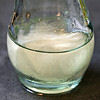
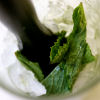



Mint Julep
Several fresh mint leaves, preferably organic, plus sprigs for garnish
3/4 oz simple syrup
2 oz bourbon
crushed ice
club soda (optional)
Place mint leaves in the bottom of a julep cup and add the simple syrup. Muddle the mint leaves just enough to bruise them all over — you don’t want to crush them into a paste, just to release their minty goodness. Let stand for a minute or two to steep. Fill the cup with crushed ice. Pour the bourbon over the ice. Stir to combine and chill, until the cup is good and cold. If there’s room in the cup and you are so inclined, feel free to add a splash of club to lighten it up. Garnish with mint sprig.
If you want to make juleps for a crowd, muddling is too time-consuming. You can make a whole batch of mint-infused simple syrup by steeping a combination of fresh mint and mint tea bags in your syrup for a few minutes, then straining it well, squeezing the mint and teabags to release the maximum mint flavor. Pour the cocktail with the same proportions, minus the muddled mint.
Drink of the Week, drinks, other blogs, recipes
8 Comments »




 All the cool kids are taking blog-sabbaticals this summer. Oh, how I wish that were the reason why we’ve been so blissfully post-free. Truth is, we’ve got plenty of inspiration, and we’re cooking up a storm. We’ve had a week of meals lined up, shopped for, and planned to a fare-thee-well. But – sadly, right in the heart of the best-eating time of the year – we’re more than a little off our game.
All the cool kids are taking blog-sabbaticals this summer. Oh, how I wish that were the reason why we’ve been so blissfully post-free. Truth is, we’ve got plenty of inspiration, and we’re cooking up a storm. We’ve had a week of meals lined up, shopped for, and planned to a fare-thee-well. But – sadly, right in the heart of the best-eating time of the year – we’re more than a little off our game.








 The piña colada enjoyed its 15 minutes of fame in 1979, long before the idea of cocktails really entered my brain. The reason: A pop song by one-hit-wonder
The piña colada enjoyed its 15 minutes of fame in 1979, long before the idea of cocktails really entered my brain. The reason: A pop song by one-hit-wonder 










 Sometimes, my palate is a live illustration of the law of unintended consequences. The combination of our
Sometimes, my palate is a live illustration of the law of unintended consequences. The combination of our 




 Last year, I put myself on a
Last year, I put myself on a 




 In a mixing glass (or cocktail shaker), muddle the peach and the sage with the syrup (if needed, depending on the sweetness of the peach), to make a pulp. Top with ice; add the brandy, Cointreau, bitters, and lemon juice.
In a mixing glass (or cocktail shaker), muddle the peach and the sage with the syrup (if needed, depending on the sweetness of the peach), to make a pulp. Top with ice; add the brandy, Cointreau, bitters, and lemon juice.  It’s good to have friends among the landed gentry. In the warm suburbs beyond the fog-wrapped City limits, we’re on friendly terms with plenty of folks who find themselves rolling in a bumper harvest of astonishing variety, looking for creative ways to eat everything before it goes off. Meanwhile, we slickers sit on our decks and wonder if the tomatoes are ever going to ripen, if the basil will survive another week, if the mint might yield enough leaves to make a
It’s good to have friends among the landed gentry. In the warm suburbs beyond the fog-wrapped City limits, we’re on friendly terms with plenty of folks who find themselves rolling in a bumper harvest of astonishing variety, looking for creative ways to eat everything before it goes off. Meanwhile, we slickers sit on our decks and wonder if the tomatoes are ever going to ripen, if the basil will survive another week, if the mint might yield enough leaves to make a 




 Okay, honest, I never intended for this garden tour to become a summer-long thing. I started in June, figured that I’d post a few times and be done by early July. Now here it is August already. Where do the days go?
Okay, honest, I never intended for this garden tour to become a summer-long thing. I started in June, figured that I’d post a few times and be done by early July. Now here it is August already. Where do the days go?




 If you want to play baseball with four strikes in an out, I’m not stopping you. Throw a party on February 31 — knock yourself out. Put “i” after “e”, wear white shoes before Memorial Day, spit into the wind, and
If you want to play baseball with four strikes in an out, I’m not stopping you. Throw a party on February 31 — knock yourself out. Put “i” after “e”, wear white shoes before Memorial Day, spit into the wind, and 




 In my new favorite cookbook,
In my new favorite cookbook, 




 Editor’s note: Inspired by our recent
Editor’s note: Inspired by our recent 




